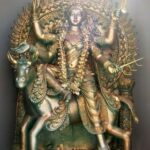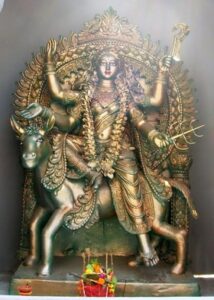Kālarātri on seitsmes Navadurgana tuntud jumalanna Durga üheksast vormist. Esmakordselt viidatakse temale Durga Saptashati, Markandeya Purana peatükkides 81–93, mis on kõige varasem teadaolev kirjand jumalanna Durga kohta. Kālarātri peetakse laialdaselt üheks paljudest jumalanna hävitavatest vormidest, mille hulka kuuluvad Kāli, Māhakāli, Bhadrakāli, Bhairavi, Mṛtyu, Rudrani, Chamunda, Chandi ja Durga.
Silpa Prakašas viidatud iidne tantristlik tekst Saudhikagama kirjeldab jumalanna Kālarātri kui jumalannat, kes valitseb ööd. Teda seostatakse ka kroontšakraga (sahasrara tšakra), andes seeläbi pöördujale siddhid ja niddhid (teadmised, väe ja rikkuse).
Devi vorm:
Ema Kālarātri on Durga kõige hirmutavam vorm. Tema jume on tume, teda kujutatakse paksude tumedate lahtiste juustega. Tal on neli kätt ning ta kannab kahes käes mõõka ja piksenoolt. Ülejäänud kaks kätt varada (õnnistavas) ja abhaya (kaitsvas) mudras. Tal on kolm silma ja kui ta hingab, tuleb ninast välja leek. Tema kaelakee särab nagu Kuu paistab öösel. Tema sõidukiks on eesel.
Devi Mahatmyami viies kuni kümnes peatükk on pühendatud asurate Shumbha ja Nishumbha ning nende liitlaste tapmisele. See eepose kolmas osa on pühendatud Maha Sarasvatile. See käsitleb veel ühe meie võimsaima vaenlase kukutamist: tegelikkuse mitteteadmise ehk teadmatuse (avidya). Kõik meie inimlikud probleemid tulenevad sellest, et me ei tea, kes me oleme, mis meiega toimub ja mis meiega juhtuda võib. Seega on ajñana ehk tavaline teadmatus see peen jõud, mis meid tõeliselt kütkeisse kinni seob. Mõistus vahutab ja ihaldab ainult seetõttu, et me ei tunne ülima tõe olemust. Kui tarkuse päike on kaetud pilvedega, kogevad meie meeled pimedust, milles ihade tsüklon võib meid jalgelt pikali pühkida ning suunata meid vihkamise ja viha keeristormi. Niikaua kui jivatman ei ole teadlik oma hiilgavast piiramatust olemusest, lõõtsutab endiselt ihade tornaado.
Inimese teadmatuse juured on kolmes kosmilises gunas: tamas, rajas ja sattva. Eepiline lugu Shumbha ja Nishumbha hävitamisest esindab nende gunade kosmilise loomuse ületamist ja ümberkujundamist. Sattva on peen takistuse kandja. See on nagu läbipaistev klaas, mis ei takista teie vaadet, vaid takistab teie lähenemist sisemisele reaalsusele ehk olemusele. Psühholoogiliselt väljendub see enesega rahulolu ja rahuldust selles, mida arvame olevat saavutanud. Esoteeriliselt iseloomustavad neid tundeid Shumbha ja Nishumbha. Ainult Maha Sarasvati, kõrgeima tarkuse jõud, suudab neid hajutada. Vabanemine ei ole individuaalne pingutus. See on kosmiline ettevõtmine, milles meid aitavad suured taevalikud jõud. Kui astute vaimsele teele, peate oma väiklased individuaalsed kontseptsioonid selja taha jätma ja astuma kosmiliste suhete teele. Vaimne otsija ei ole lihtsalt tavaline indiviid nagu miljonid teised, vaid eriline inimene, sest ta on ühendatud universaalse reaalsusega. Devi Mahatmyam kaasab meid sellesse kosmilisse tantsu, mis võidab tamase, radjase ja sattva jõud ning aitab meil saavutada kõrgeima mõistmise. Selles aitavad meid Adi Shakti suured väed.
Shumbha iseloomustab seda osa meie olemusest, mis seisab pidevalt vastu tõele, et me kõik oleme põhimõtteliselt ühesugused ja kõik lähtume ülimast. Oleme enesekindlad individualistid ega loobu oma eraldiseisvast egost isegi siis, kui meile lubatakse Jumala riiki. Meil on raske leppida tõsiasjaga, et me ei saa sundida jumalikku meie tahtele alluma. Kui ta ei paindu meie tahtele, tunneme samasugust pettumust ja viha nagu Shumbha. Meile on antud Jumalaema poolt täielik vabadus seda ideed edasi etendada ja võidelda temaga pikka aega – kuni saabub hetk, mil ta otsustab, et me peaksime oma tõelist olemust teadvustama.
Shumbha üldine Raktabija on allegooria meie ebatervislikele mõtetele, mis paljunevad, kui jäetakse toituma meid ümbritsevast negatiivsusest. Need tuleb tabada, enne kui nad juurduvad meie alateadvuses ja paljunevad väljaspool meie kontrolli. Selleks tuleb Kaali kutsuda. Üksi jättes kivistuvad need mõtted meie isiksusesse ja siis ei saa me neid kunagi välja juurida. Nagu Svami Shivananda ütleb: "Pidev valvsus on vaimse vabaduse hind."
Devi Mahatmyam on lugu sisemisest lahingust. Võit tuleb meile alles siis, kui leiame jõudu anda oma negatiivsed emotsioonid Durga puhastavale tulele. Siin kirjeldatud erinevat tüüpi konfliktid juhtuvad tegelikult iga päev meie südames ja välismaailmas. Me peame pidevalt sõda oma negatiivsete ja positiivsete emotsioonide vahel. See on lahing, mida peab võitlema iga põlvkond. Vastused peab andma Jumalik Ema ise. Kui me talle alla ei anna, ei saa me kunagi konflikti lõpetada. Kui proovime nagu Chanda ja Munda jumalannat trotsida ja tema erilisi võimeid enda huvides anastada, saab ta raevukaks ja tema ilusast vormist väljub kohutav Kāli, aja vägi, kes neelab meid endasse oma ägedate kihvadega.
Kālarātri Mantra:
एकवेणी जपाकर्णपूरा नग्ना खरास्थिता।
लम्बोष्ठी कर्णिकाकर्णी तैलाभ्यक्त शरीरिणी॥
वामपादोल्लसल्लोह लताकण्टकभूषणा।
वर्धन मूर्धध्वजा कृष्णा कालरात्रिर्भयङ्करी॥
ekaveṇī japākarṇapūrā nagnā kharāsthitā|
lamboṣṭhī karṇikākarṇī tailābhyakta śarīriṇī||
vāmapādollasalloha latākaṇṭakabhūṣaṇā|
vardhana mūrdhadhvajā kṛṣṇā kālarātrirbhayaṅkarī||
Tähendus: „Ta on alasti, sõidab eeslil, on pika keelega, läikiva kehaga, kannab jalgadel kaunistusi nagu välk, on musta värvi, lahtiste juuste, suurte silmade ja kõrvadega ning väga ohtliku välimusega. Selle Kalratri vormi mediteerimine eemaldab kõik takistused ja eemaldab kõik teiste loodud maagilised efektid. "
Durga Saptashati 1. peatükk, salm 75, viitab hävitavale printsiibile, millega on jumalanna Kaalratri kirjeldatud kõigis Puranades:
prakṛtistvaṃca sarvasya guṇatraya vibhāvinī
kāḷarātrir mahārātrir moha rātriśca dāruṇā
Sina oled algne, esmane põhjus kõigele
andes väe kolmele kvaliteedile (sattva, rajas ja tamas)
Oled perioodilise lahustumise tume vägi
Oled lõpliku lahustumise suur öö ja kohutava pettekujutluse öö
ENG
Kālarātri is the seventh of the nine forms of the Goddess Durga, known as the Navadurga. She is first referenced in the Durga Saptashati, Chapters 81-93 of the Markandeya Purana, the earliest known literature on the Goddess Durga. Kālarātri is widely regarded as one of the many destructive forms of the Mother Goddess, which include Kali, Mahakali, Bhadrakali, Bhairavi, Mrityu, Rudrani, Chamunda, Chandi and Durga.
The Saudhikagama, an ancient Tantric text referenced in the Silpa Prakasha, describes Goddess Kālarātri as being the goddess that rules the night portion of every day and night. She is also associated with the crown chakra (also known as the sahasrara chakra), thereby giving the invoker, siddhis and niddhis (particularly, knowledge, power and wealth).
Ma Kālarātri is the most fierce forms of Durga. Her complexion is dark as night ad has untied bountiful hair. She has four hands and carries a scimitar and a thunder bolt in two of her hands. Other two hands are and the right two are in the varada (blessing) and abhaya (protecting) mudras: ‘giving’ and ‘protecting’. She has three eyes and flames come out of her nostrils when she breathes. Her necklace shines like the Moon shines in the night. Her mount is a donkey.
The fifth through the tenth chapters of the Devi Mahatmyam are devoted to the killing of the asuras Shumbha and Nishumbha and their allies. This third section of the epic is devoted to Maha Saraswati. It deals with the overthrow of another most powerful enemy: ignorance of reality or avidya. All our human troubles arise from the fact that we are in total ignorance of who we are, what is happening to us, and what may happen to us. Thus ajñana or ordinary ignorance is the subtle power that really binds us. The mind churns and desires only because we do not know the nature of supreme truth. When the sun of wisdom is covered with clouds, our minds experience a darkness in which the cyclone of desire can sweep us off our feet and project us into a maelstrom of hate and anger. As long as the jivatman is unaware of its own effulgent nature, the tornado of desire will keep blowing.
Human nescience has its root in the three cosmic gunas: tamas, rajas, and sattva. The epic story of the destruction of Shumbha and Nishumbha represents the overcoming and transformation of cosmic nature in the form of these gunas. Sattva is a subtle medium of obstruction. It is like a clear pane of glass that does not obstruct your view but obstructs your approach to the reality within. Psychologically, it manifests as feelings of complacency and satisfaction with what we think we have achieved. Esoterically, these feelings are typified by Shumbha and Nishumbha. Only Maha Saraswati, the power of higher wisdom, can dispel them. Liberation is not an individual effort. It is a cosmiccan endeavor in which we are helped by the great celestial powers. When you step into the spiritual path, you have to leave your petty individual concepts behind and cross into the way of cosmic relationships. A spiritual seeker is not just another individual like millions of others but a special person, for he or she has connected with the universal reality. The Devi Mahatmyam involves us in this cosmic dance that overcomes the powers of tamas, rajas, and sattva and helps us attain supreme realization. In this we are helped by the great forces of Adi Shakti.
Shumbha typifies that part of our nature that keeps resisting the truth that we are all fundamentally the same and all emanate from the supreme. We are confirmed individualists and will not give up our separate egos even if we are promised the kingdom of God. We find it difficult to accept the fact that we cannot force the divine to obey our will. When she doesn't bend to our will, we feel the same frustration and anger as Shumbha. We are allowed full freedom to entertain this idea and combat with her for long time - until the moment comes when she decides that we should be made aware of our true nature.
Shumbha's general Raktabija is an allegory for our unhealthy thoughts, which multiply if left to feed on the negativity that surrounds us. They have to be caught before they take root in our subconscious and multiply beyond our control. Kaali has to be invoked to do this. If left alone, these thoughts will harden into our personality, and then we will never be able to eradicate them. As Swami Shivananda says, "Constant vigilance is the price of spiritual liberty."
The Devi Mahatmyam is the story of an inner battle. Victory comes to us only when we find the strength to surrender our negative emotions to Durga's purifying influence. The different types of conflicts that are described here actually happen daily within our hearts and in the external world. We are constantly waging a war between our negative and positive emotions. It is a battle that has to be fought by every generation. The answers have to be given by the Divine Mother herself. Unless we surrender to her, we can never end the conflict. If, like Chanda and Munda, we try to defy the goddess and usurp her special powers for our own benefit, she become enraged and out of her beautiful form will emanate the terrible figure of Kaali, the power of time, who will devour us with her fierce fangs.
Kālarātri Mantra :
एकवेणी जपाकर्णपूरा नग्ना खरास्थिता।
लम्बोष्ठी कर्णिकाकर्णी तैलाभ्यक्त शरीरिणी॥
वामपादोल्लसल्लोह लताकण्टकभूषणा।
वर्धन मूर्धध्वजा कृष्णा कालरात्रिर्भयङ्करी॥
ekaveṇī japākarṇapūrā nagnā kharāsthitā|
lamboṣṭhī karṇikākarṇī tailābhyakta śarīriṇī||
vāmapādollasalloha latākaṇṭakabhūṣaṇā|
vardhana mūrdhadhvajā kṛṣṇā kālarātrirbhayaṅkarī||
Meaning: “She is naked, rides on an donkey, has a long tongue, lustrous body, wears ornaments on her legs like lightning, is black in color, has unlocked hair, big eyes and ears and is very dangerous looking. Meditating on this form of Kalratri removes all obstacles as well as removes all magical effects created by others.”
Chapter 1 of the Durga Saptashati, verse 75, references the destructive concept personified by Goddess Kaalratri in all Puranas:
prakṛtistvaṃca sarvasya guṇatraya vibhāvinī
kāḷarātrirmahārātrirmoharātriśca dāruṇā
You are the primordial cause of everything
Bringing into force the three qualities (sattva, rajas and tamas)
You are the dark might of periodic dissolution
You are the great night of final dissolution and the terrible night of delusion
Oṁ Devi Kālarātryai Namaḥ

